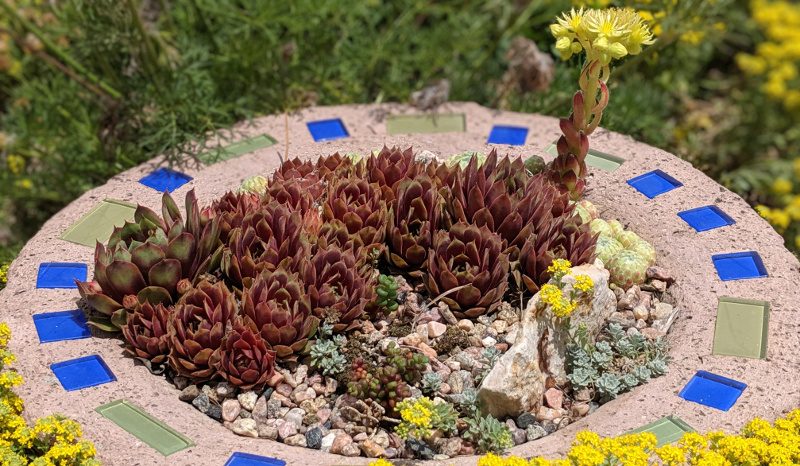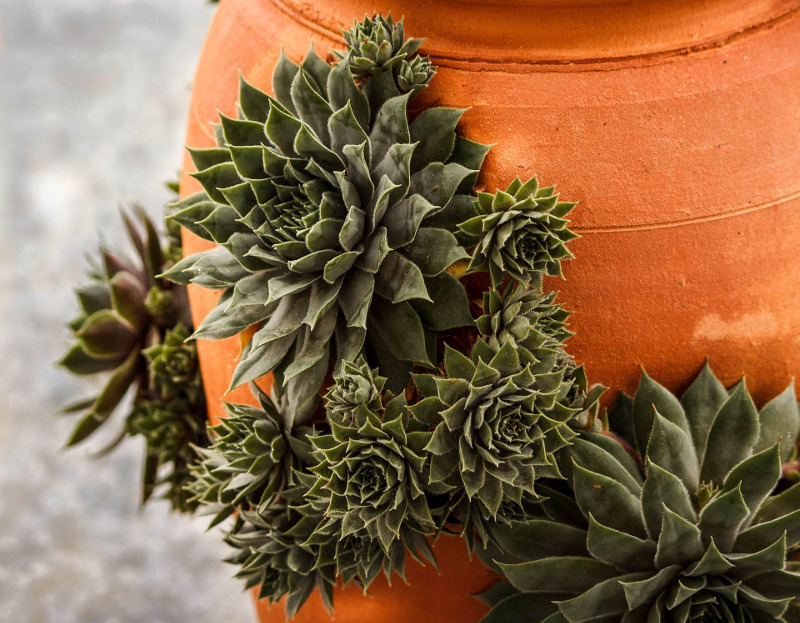You can grow Hens and Chicks (Sempervivum tectorum) in all sorts of containers. The spreading chicks will fill the container and even spill over the side for a fun and easy container plant. Containers with hens and checks also look terrific sitting on steps or terrace walls, where the chicks can hang down the side and soak up sun.
Since Hens and Chicks can handle cold better than many succulents, you can place containers outside for much of the year so your deck or patio. The plants need some cold nights so they can go dormant, but not bitter cold or a hard freeze, so bring them in before freezes. Also remember that a container is not as warm as the ground, so don't assume your container-planted Sempervivum can take the same cold as those planted outdoors.

Planting Hens and Chicks in Pots
Succulents like Hens and Chicks love heat but will do best if planted during mild seasons like late winter or early spring. If you are keeping the plants mostly indoors, you can plant them when it is a little cooler. If it is peak heat of summer, gently introduce Hens and Chicks to full sun.
Hens and Chicks need lots of sun to grow and bloom. So, place the container where they will get plenty of sun outdoors or indoors in winter. The succulent has shallow roots, so you can plant them in nearly any size or depth of container but shallow and wide ones will be best. Common container materials are fine, such as terracotta. Just be sure your container has good drainage. The main plant lasts two to three years, and you can repot it if lots of chicks form and outgrow the container.
Best Soil For Hens and Chicks in Pots
Hens and Chicks, like most succulents, do best in soil that drains well; they also can grow fine in "poor" soil, meaning they need no added nutrients or compost. Typical container potting mixes hold too much moisture. Free-draining soil with at least 30 percent grit or sand will yield the healthiest succulents (you can add sand and grit to typical container potting mix).
The best soil you can purchase is a cactus soil mix. If you like, top off the container by adding some decorative rocks, gravel or glass beads. The rocks help gather heat and will fill in empty spaces until the plant grows so your container looks better. Hens and chicks also grow in rock crevices outdoors, so once you get the hang of growing them in containers, plant one between some large rocks in a wide, shallow pot and enjoy.

Caring For Hens and Chicks in Planters
Hens and Chicks are easy to grow and maintain; just don't overwater them. Be sure to place your container so it gets at least six hours of bright light, but not direct light up against the window, which can burn the plants. You can set the plants outside in summer, following a similar six hours of sun a day.
Watering Hens and Chicks in Pots
Succulents like Hens and Chicks store water in their leaves or pads. This means that once established, they need little watering. Water your new plants regularly, but only when the soil feels dry if you stick your finger in an inch or so. When you water, apply a slow, low stream around the container, not a flush of water. Don’t let the container soil stay wet and once a plant is healthy and growing, it can handle some periods of drought.
Rainwater is good for watering succulents like Hens and Chicks. Or you can alternate between distilled water and rainwater to avoid turning your soil too acidic. Tap water often has too many minerals, which eventually can build up in the soil.
Fertilizing Hens and Chicks in Pots
Hens and Chicks seldom need fertilizer because they grow well in poor soil. If you want to fertilize the plants, add an all-purpose, balanced fertilizer at a low concentration in spring. Avoid fertilizing when the containers are outside in the heat of summer or during cold winter months.
Winter Care for Hens and Chicks in Pots
The container holding Hens and Chicks should be taken inside before the first frost to avoid damage. If a container is too heavy to pick up, push into a sunny winter spot, like against a south-facing wall, to overwinter the plants. You also can wrap containers with bubble wrap or other materials to help insulate them.
If a container cracks, it is time to separate and transplant Hens and Chicks and leave the new, smaller containers indoors during winter. Just continue to give the plants plenty of bright but indirect sun in winter, moving them to match the path of sun through the windows.
Can Hens and Chicks Be Grown Indoors?
If an indoor area gets at least six hours of bright sunlight a day, Hens and Chicks can thrive indoors. The plants tend to go dormant in winter when left outside, don't expect them to grow even indoors during winter. All plants need a rest. Cut back on watering even more during cool winter months.
 |
Author Teresa Odle - Published 5-11-2020 |
